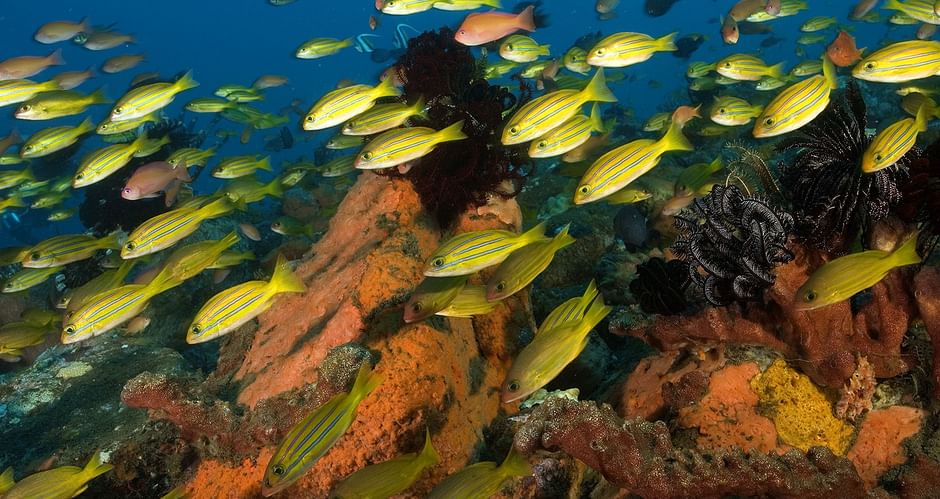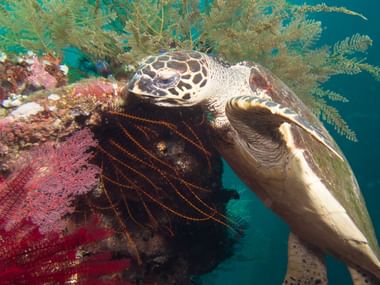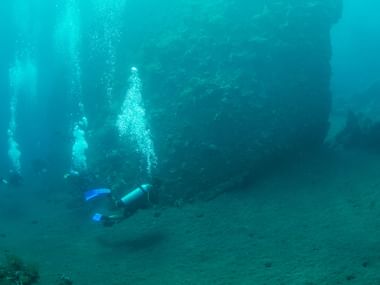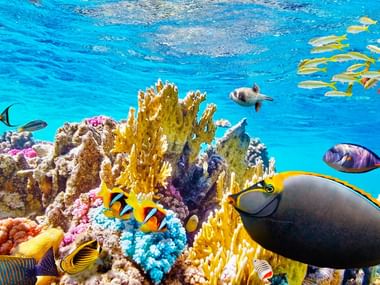This guide is written by Mads Staal, who is Bering Travel's diving expert. Mads has worked as a diving instructor in Bali and has made hundreds of dives in the waters. All photos above were taken by Mads.
Guide to the best dives in Bali



This guide is written by Mads Staal, who is Bering Travel's diving expert. Mads has worked as a diving instructor in Bali and has made hundreds of dives in the waters. All photos above were taken by Mads.

On the east coast of Bali is the small harbour town of Padang Bai. From here you can take the ferry to Lombok or the popular Gili Islands.
This area offers perfect diving and snorkelling opportunities for beginners, as well as diving experiences for those with Advanced Open Water and above.
Padang Bai offers white sandy bottoms, beautiful corals of all colours and a magical opportunity for muck diving.
The abundance of marine life has something for everyone, from tiny clownfish, to blue-spotted stingrays and sea turtles, to white-tip reef sharks. Plus, there's plenty of opportunity to take a closer look at the marvellous macro marine life!
A traditional longboat takes you out from Padang Bai. Just 10 minutes from the shore, you can choose to make your first stop at Blue Lagoon.
This is one of the most popular dive sites in Bali. With the always beautiful blue water, it's clear to see how it got its name. The site is perfect for beginners as well as snorkelling trips, as you start on sandy bottoms at a depth of five metres. From here you can move out towards the beautiful corals, where you can get down to a depth of 20 metres. However, you'll often move around the 12-15 metres in this area, as this is where you'll encounter the most marine life.
At Blue Lagoon, you're most likely to see clownfish, sea turtles, moray eels, seahorses and all kinds of coral fish.
This place offers a lot of fun and different experiences. Here you have the opportunity to see how corals have been successfully grown in Bali. The cultivated corals hang on racks, like grape vines in a vineyard. This growing process has been pioneered by marine biologists around the world, who have been allowed to replicate the process in the hope of reducing the extinction of the world's coral reefs.
In addition to coral farming, there are also plenty of opportunities to see nature's own corals. Here you may be lucky enough to encounter the popular razor-fish. This fish always travels in large groups. It gets its name because it resembles a razor blade in its body shape. With their heads down, they move up and down on the sandy bottom constantly - making it look like a ballet dance.
Down about 25 metres you'll find a well-preserved wreck - a small fishing boat. Here you may be lucky enough to encounter large groups of catfish.
In addition to a lot of exciting fish, you may also come across a submarine. It sails out from Padang Bai and takes tourists who are not brave enough to dive underwater. It's always a fun experience to encounter a submarine during your dive. Often the diver is turned into an attraction for the guests on board the submarine. So if you're photogenic, there's plenty of opportunity to show off your best poses if you happen to come across the submarine during your dive.

Bias Tugal is Indonesian for 'white beach'. This is named after the small chalky white sandy beach that you can see when you jump into the water.
This dive offers an exceptional variety of corals in all colours and formats!
The corals range from 5 metres out to a sloping wall that can take you down to a maximum depth of 45 metres, where you can look down into the endless blue depths! If you get that deep, you might be lucky enough to see sunfish!
In addition to sea turtles, stingrays and the typical coral fish, you'll come across the colourful and beautiful nudibranchs. These snails come in thousands of different colours and shapes and always make for perfect underwater photos as they sit perfectly still on the coral.
Many of the corals form large bumps that resemble the mushroom houses that Smurfs live in. In these "houses", two white tip reef sharks have chosen to take up residence. Unless they are out hunting small coral fish, you might be lucky enough to come across this pair. They can be curious, so don't be alarmed if they swim very close to you. They only eat very small coral fish, so there's nothing to fear. Lie very still in front of their burrow and have your camera ready. You're almost guaranteed a great close-up photo of yourself with a shark - who wouldn't want one of those!
Mimpang is for the more trained and experienced divers. Here you will typically choose to dive with nitrox, as much of the life is found at depths of 20-35 metres.
Here you'll encounter lots of white tip reef sharks, sea turtles, ribbon eels and huge schools of colourful fish!
However, the site is best known for its high chances of seeing the famous sunfish! The sunfish live at a depth of 2-4km, but occasionally come up to a depth of 20-30 metres to be cleaned and soak up the sun's energy before disappearing back into the depths. It's not unnatural to encounter up to 5 sunfish during 1 dive!!! However, should you be lucky enough to come across one, make sure you don't get too close to it as it is very shy and this will result in it swimming back into the depths in a hurry. Therefore, enjoy the sight of this amazing creature at the distance your dive instructor recommends you are at.

Nusa Penida is one of the smaller inhabited islands off the coast of Bali. The boat trip itself takes 30-45 minutes depending on weather conditions. Be aware that the waves can be high, depending on the wind and weather. So make sure you have seasickness pills on board or get some from your dive instructor.
On the boat trip out to the island, you may be lucky enough to encounter dolphins and flying fish, so keep an eye on the sea as you sail out.
This place is named after the large stingray Manta Ray! This is the place where they dive with Manta Rays in "heading for distant shores".
Manta Point is rich in plankton and also acts as a cleaning station for the larger fish. On some days you may see 1 to 2 Manta Rays. On other days you can see up to 20 of them! They are very friendly and swim peacefully around you - and may even play with the tickling bubbles from the divers.
The waters at Nusa Penida are often very chilly, so make sure to wear a full 3mm suit on all dives.
Crystal Bay offers a wealth of colourful corals. Visibility is almost always good!
This site goes from 5 metres out to a wall of coral that disappears into the depths. Out by the wall, it's not uncommon to come across a sunfish that's up to soak up the sun.
In the shallower waters, you'll come across the blue/white/black striped sea snakes. Don't be afraid of them if they come very close to you - they are blind and navigate by vibrations in the water. Furthermore, their teeth are soft and therefore cannot bite through human skin.
There are also plenty of opportunities to encounter sea turtles and parrotfish. Parrotfish are usually calm, but when they are in heat, you need to be very careful about getting close to them. Therefore, keep an eye on your dive instructor if you encounter a parrotfish and navigate according to the instructor's instructions.
Crystal Bay is a must dive if you're in Bali as it has so much variety to offer!

This place is an amazing drift drive! Drop into the depths and let the current carry you along for the entire dive.
S.D. Point has an incredibly beautiful coral wall that you drift along throughout the dive. Peer into the coral and try to spot the many moray eels and sea snakes hiding in there. You might also be lucky enough to spot large crabs here!
Also make sure to look out into the endless blue as you might be lucky enough to spot a black tip!
S.D. Point often takes divers' breath away as you'll be surrounded by thousands of colourful schools of fish throughout the dive!
You can get really lucky to see the black tuna in schools!
This site is perfect for family trips as it is suitable for everyone: snorkellers, first-time divers, scuba divers and experienced divers.
On the drive out to Tulamben, you'll pass by some of the world's oldest rice paddies rolling down the mountainside. You should also look into the forests, as you may be lucky enough to see large herds of monkeys in the trees.
Tulamben itself is a large volcano that you can arrange to climb at night and watch the sunrise from.
The USS Liberty Ship is an American ship that was built in 1918 and was fired upon by a Japanese torpedo in 1942. The captain managed to navigate the ship into the north coast of Bali, but it was so badly damaged that it was wrecked off the coast after the crew on board abandoned it.
In 1963, there was a volcanic eruption from Gunung Agung. The volcano hit the USS Liberty and the large ship was broken into pieces by the eruption. As a result, the USS Liberty is now at a depth of 5 to 30 metres.
The dive is one of the best wreck dives in the world and it's easy to see why! Despite the volcanic eruption, it is a hugely well-preserved wreck. For the more experienced divers, there is the option to dive into some of the rooms on the wreck.
The wreck is home to large amounts of coral. You can also see giant oysters, which are completely open but close when you approach them. Sea turtles and black tip sharks are also a common sight at this wreck.
At the start of the wreck at a depth of 5 metres, you may be lucky enough to encounter a friendly barracuda, which always comes up to greet divers when it is present. It has a very intimidating appearance, but don't be afraid of it as it has been living side by side with divers for many years. Instead, enjoy it and get some great shots of the cuddly barracuda - if you have more space on your memory card after an incredible wreck dive!

Not far from the USS Libery is the Coral Garden.
This is a very simple but incredibly beautiful dive, as the corals here attract all kinds of fish.
At the start of the dive you come across a skeleton from a crashed aeroplane. Here you may be lucky enough to see lionfish and the beautiful ribbon eel. From here you move towards the "garden" itself, which is a mass of Buddha statues and small temples located at a depth of 10-15 metres. Amongst these statues and temples you can see a lot of amazing fish! For example, you might be lucky enough to come across groups of the big Elvis fish!
Look closely at the sandy bottom as well, as there may be blue spotted stingrays, ribbon eels, and not least the cuttle fish - an incredible animal related to the octopus that changes colour constantly as it swims around above the coral.
There's also a large pile of car tyres close to the 'garden' that's well worth a visit! Put your hands into the tyres and you'll find that little cleaner crabs will start "clipping" all the dead skin off your fingers - an incredibly fun and tickling experience!

